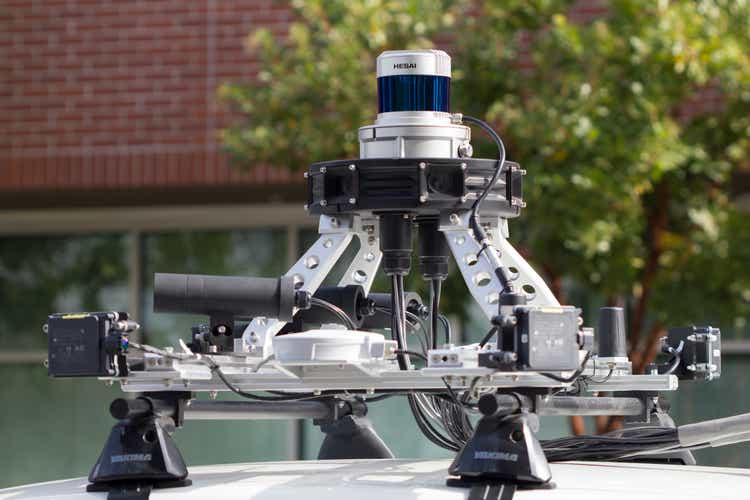hapabapa
Although lidar developer Cepton (NASDAQ:CPTN) has signed a deal with major manufacturer GM (GM) to provide lidar units for its L3 ADAS Ultra Cruise, set to roll out in 2023, the dilutive risk ahead as well as a long road to profitability as revenues have yet to scale dim the outlook ahead.
GM’s Deal To Be Low-Volume To Start
As the lidar industry prepares to progress past an infancy stage into a full-blown emerging growth industry throughout the remainder of the decade, early deals and customer wins can help cement long-term success. For Cepton, a supply deal with GM and prior collaborations with Ford (F) are two positives, with both OEMs producing high volume, popular vehicles.
With GM, Cepton will be supplying lidar for future L2+ ADAS equipped vehicles, with the first deployment coming with the launch of GM’s L3 ADAS Ultra Cruise.
Ultra Cruise is set to be launched in 2023 on the luxury Cadillac CELESTIQ EV, which is expected to enter production in December 2023. This suggests that production and sales volumes of Cepton’s lidar units to Cadillac are likely to begin scaling during FQ4 ’23 when production commences; however, the extent to which Cepton’s volumes can scale with Cadillac are limited.
The reason: the CELESTIQ will be handmade, with a production capacity of about 1.2 vehicles per day, or 500 vehicles per year. With Cepton’s lidar selling for a sub-$1,000 price point, revenues stemming from the CELESTIQ launch could near $1 million assuming each vehicle features two lidar units.
Cepton had collaborated with Ford on an autonomous shuttle project, which completed in August, but Ford’s recent pull-out from Argo AI opens the door for a new lidar supplier to potential fill the gap. However, the step away from full-fledged autonomy does not bode well for Cepton, since that was the area of concentration for the collaboration.
The rollout of Ultra Cruise beginning late next year provides an opportunity for Cepton’s product revenues to scale, but it looks to be a slow ramp to start. Product revenues increased 171% y/y to $1.8 million for Q3, but rose just $0.33 million sequentially.
Far From Profitability
Even though revenues and lidar shipments have the opportunity to scale with GM scaling Ultra Cruise into 2024 and beyond, Cepton remains far from profitable.
Currently, Cepton is spending $8 million to make $1 million in revenue, which is not sustainable; however, this dynamic is likely to remain until lidar revenues can reach $20 million per quarter, or until volumes scale substantially, allowing for economies of scale to exist.
Over the next four to six quarters, product development costs are likely to continue to rise, as R&D is vital in the lidar industry to advance product capabilities and offer cutting-edge technology needed to secure customer wins. Scaling production also will send SG&A higher, so profitability is likely eight to twelve quarters in the future, at minimum.
Cepton is also burning cash rather quickly, with YTD cash used in operations at $43 million — this includes fair value changes in earnout liabilities in regards to the SPAC combo — but cash burn rate is likely around that level as well. With the recent $100 million investment from Koito, Cepton’s current cash on hand at the end of November is estimated to be approximately $110 million, offering a six to eight quarter operating runway.
Large Dilution Risk
Koito’s $100 million convertible preferred share investment opens up the possibility for a significant amount of dilution in the future, either directly or indirectly.
The terms of the convertible share agreement set the conversion price at $2.585 per share, a 10% premium to Cepton’s 20-day VWAP up to October 26, 2022. Koito is purchasing 100,000 shares of convertible preferred stock at $1,000 per share, with a conversion rate of 386.472 shares.
Simply put, the investment is worth about 38,647,200 million shares, or ~24.7% of Cepton’s total shares outstanding as of September 30, 2022. So, if Cepton’s shares recover to over $2.59 per share, Koito could elect to convert to common shares, resulting in a dilution of nearly 25% to existing shareholders.
The investment from Koito also opens up possibilities for indirect dilution, or other dilution not related to this investment. Koito’s funding has given Cepton a multi-quarter runway with some much needed cash, but if commercialization efforts slow or customer wins fail to ramp up in the face of heightened competition, Cepton could burn through cash rather quickly with little to show for it. At share prices below $2, capital raises will be increasingly difficult as cash runs thin, but dilution via other convertible share/note offerings could still be possible.
Outlook
Even though GM’s supply deal provides Cepton with a much-needed customer win and an ability to scale lidar units into production vehicles four to eight quarters in the future, the company’s financial position remains precarious. Cepton is spending around $8 million to generate $1 million in revenues, which is unsustainable, even more so that scaling lidar revenues will take multiple quarters. Koito’s $100 million investment provided a large sum of cash for Cepton to continue operations for the next four to six quarters, but the deal comes with a massive 24.7% potential dilution risk from the conversion price and rate. As cash burn likely heightens over the next two to four quarters to scale production, future capital raises are likely to become increasingly difficult; the combination of the above factors suggest Cepton is not worth the high level of dilution or commercialization risk ahead.


Be the first to comment